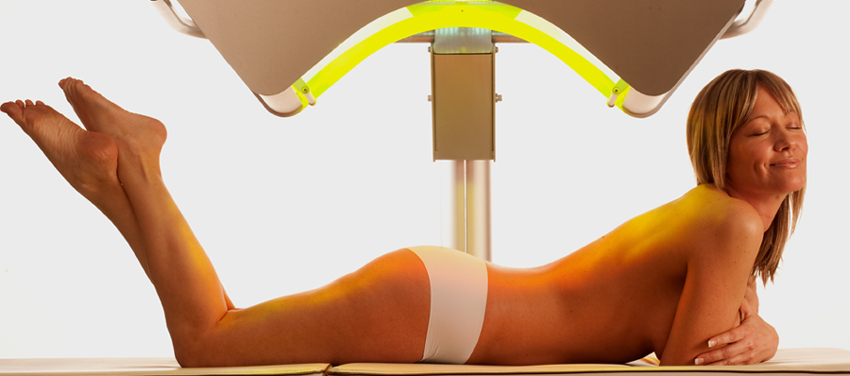
BACKGROUND
The use of low levels of visible or nearinfrared (NIR) light for reducing pain, inflammation and edema, promoting healing of wounds, deeper tissues and nerves, and preventing tissue damage has been known for almost forty years since the invention of lasers. Originally thought to be a peculiar property of laser light (soft or cold lasers), the subject has now broadened to include photo-biomodulation and photo-biostimulation using non-coherent light. Despite; well over 3500 scientific studies all over the world, the complexity of rationally choosing amongst a large number of illumination parameters such as wavelength, fluence, power density, pulse structure and treatment timing has led to the publication of a number of negative studies as well as many positive ones.
Mitochondria are thought to be a likely site for the initial effects of light, leading to increased ATP production, modulation of reactive oxygen species, and induction of transcription factors. These effects in turn lead to increased cell proliferation and migration (particularly by fibroblasts), modulation in levels of cytokines, growth factors and inflammatory mediators, and increased tissue oxygenation. The results of these biochemical and cellular changes in animals and patients include such benefits as increased healing of chronic wounds, improvements in sports injuries and carpal tunnel syndrome, pain reduction in arthritis and neuropathies, and amelioration of damage after heart attacks, stroke, nerve injury, and retinal toxicity.
HISTORY
In 1967, a few years after the first working laser was invented, Endre Mester at Semmelweis University, Budapest, Hungary wanted to test if laser radiation might cause cancer in mice. He shaved the dorsal hair, divided them into two groups and gave a laser treatment with a low powered ruby laser (694 nm) to one group. They did not get cancer, and to his surprise the hair on the treated group grew back more quickly than the untreated group. This was the first demonstration of “laser biostimulation”. Since then, medical treatment with coherent-light sources (lasers) or non-coherent light (light-emitting diodes, LEDs) has passed through its childhood and adolescence. Currently, low-level laser (or light) therapy (LLLT), also known as “cold laser”, “soft laser”, “biostimulation” or “photo-biomodulation” is practised as part of physical therapy in many parts of the world.
Currently, there is monochromatic (single wavelength) laser based light therapy equipment, LED based professional monochromatic and multiple wavelength units, and the latest plasma arc quartz lamp technology systems in the market. In the world of beauty; the photo light therapy equipment is used mainly to reduce the fine lines, low level wrinkles, tighten skin, reduce pore sizes, remove blemishes and reduce new or old scar tissue. The same equipment is also used for effectively eliminating sun damage such as brown old age spots and freckles. Many aestheticians have developed the use of the photo-therapy units very creatively to eliminate problems with other procedures, such as using a photo light session after microderme abrasion procedures to reduce the redness and inflammation.
Many professionals have come up with questions about the selection and use of the photo light equipment.
LED based units = 20 minutes to 40 minutes.
Plasma arc, new quartz technology = 10 minute sessions
LED systems will require the minimal maintenance and power consumption.
The latest plasma arc units, such as the RX-1 from Collagentex, costs as little as 8.3 cents per session in total for lamp replacement, maintenance and power consumption, according to their latest brochure.
Many equipment manufacturers do not recommend the use of direct light on epilepsy sufferers, pregnant women or pace maker wearers. Wearing metal body piercing jewellery is also not recommended.
- Build the collagen layer, increasing elasticity by 633nm as the treatment continues for 12 or more sessions.
- 660nm will aid in ATP production and increase the metabolic rate.
- 710nm, 760nm will go slightly deeper to dilate the lymphatic system and allow easier drainage of accumulated fat and toxins.
- 810nm, 852nm will increase oxygenation and will increase the blood flow further and firm up the muscles below.
- Equipment as such as the RX-Silk from Collagentex, with the patented moving paddles under the buttocks and a wave action for effective lymphatic drainage, will perform well to reduce cellulite along with use of effective cellulite creams and skin tighteners.
Article Source: Spa Canada
REFERENCES:
[1]-Michael R. Hamblin Department of Dermatology, Harvard Medical School, BAR 414
[2] E. Mester, B. Szende and P. Gartner, The effect of laser beams on the growth of hair in mice, Radiobiol Radiother (Berl) 9 (1968) 621-6.
[3] R. Roelandts, The history of phototherapy: something new under the sun?, J Am Acad Dermatol 46 (2002) 926-30.
[4] A.N. Pereira, P. Eduardo Cde, E. Matson and M.M. Marques, Effect of low-power laser irradiation on cell growth and procollagen synthesis of cultured fibroblasts, Lasers Surg Med 31 (2002) 263-7.
[5] J.S. Kana, G. Hutschenreiter, D. Haina and W. Waidelich, Effect of low-power density laser radiation on healing of open skin wounds in rats, Arch Surg 116 (1981) 293-6.
[6] A.P. Sommer, A.L. Pinheiro, A.R. Mester, R.P. Franke and H.T. Whelan, Biostimulatory windows in low-intensity laser activation: lasers, scanners, and NASA’s light-emitting diode array system, J Clin Laser Med Surg 19 (2001) 29-33.
[7] J.C. Sutherland, Biological effects of polychromatic light, Photochem Photobiol 76 (2002) 164-70.
[8] T. Karu, Laser biostimulation: a photobiological phenomenon, J Photochem Photobiol B 3 (1989) 638-40.
Comments are closed

